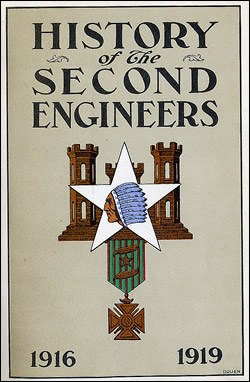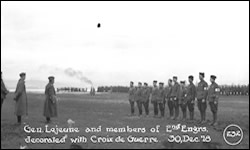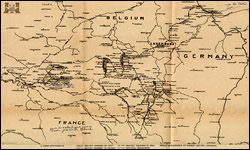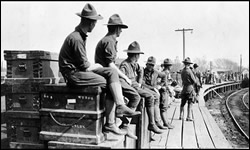History of The Second Engineers
1916-1919 |
| (inc. personal notes of Herley
W. Wilson) |
|
- Roll Of Honor
- Contents
- Illustrations
- Preface
- Introduction
- In Mexico
To The Memory Of Those Whose Names Compose The Roll of Honor |
| Dulce et decorum est pro patria mori. |
| |
|
Captain
| X |
Captain Jesse Lowen |
|
|
Captain George R. Spaulding |
|
| X |
Captain Myron H. Peck |
|
|
Captain Frank W. Hulett |
|
|
First Lieutenant
| |
First Lieutenant Malcolm Johnston |
|
| |
First Lieutenant Robert W. Nolte |
|
| X |
First Lieutenant
James Henderson Spafford |
|
Second Lieutenant
|
Second Lieut. Stephen P. McGroarty |
|
| |
Second Lieut. Charles A. Dean |
|
|
Master Engineer
|
Master Engineer Hugh G. Middleton |
|
| X |
Master Engineer Richard I. Rhodes |
|
Wagoner
| |
Wagoner Thomas Duncan |
|
| |
Wagoner John A. Hamilton |
|
Other
|
First Sergeant Chauncey F. Yingst |
|
| |
Supply Sergeant Robert Ronson, Jr. |
|
| |
Cook Walter L. Crouch |
|
| |
Bugler Orra L. Snyder |
|
Sergeant First Class
|
Sergeant First Class George A. Hopp |
|
| |
Sergeant First Class Floyd E. Roderick |
|
| |
Sergeant First Class Joseph Geiger |
|
| X |
Sergeant First Class Earl S. Finley |
|
| |
Sergeant First Class Alvin W. Dean |
|
|
Sergeant First Class Edwin D. Waltman |
|
| |
Sergeant First Class Willie H. White |
|
| X |
Sergeant First Class Albert G. Justice |
|
Mess Sergeant
| |
Mess Sergeant John W. Hanley |
|
|
Mess Sergeant Patrick F. Crowley |
|
Sergeant
| |
Sergeant Harry T. Corbin |
|
| |
Sergeant Howard E. Dickerson |
|
|
Sergeant John W. Raezer |
|
|
Sergeant Boyd F. Mulligan |
|
| |
Sergeant Marvin N. Howze. |
|
| |
Sergeant Carl Gilbert |
|
| |
Sergeant John V. Showers |
|
| |
Sergeant Patrick Patterson |
|
| |
Sergeant Leo L. Lane |
|
| |
Sergeant William J. Cottingham |
|
|
Sergeant Fred A. Howard |
|
| X |
Sergeant Lyle R. Voorhees |
|
|
Sergeant Percy D. Cox |
|
|
Corporal
|
Corporal Louis M. Holmes |
|
| X |
Corporal Mart Gentry |
|
| |
Corporal Charles L. Joy |
|
| |
Corporal George Bell |
|
| |
Corporal Jens C. Anderson |
|
| |
Corporal William Fleming |
|
| |
Corporal Frank Tucker |
|
| |
Corporal Ivie L. Rigdon |
|
| |
Corporal Benjiman J. Hamby |
|
| |
Corporal Fred A. Sell |
|
| |
Corporal Clyde A. Smelzer |
|
| X |
Corporal William P. Gallagher |
|
| |
Corporal Louis Cohen |
|
| |
Corporal Stephen P. Grib |
|
| |
Corporal Gust Kolar |
|
| |
Corporal Frank S. Lamb |
|
| |
Corporal John E. High |
|
| |
Corporal Fred M. Allison |
|
| |
Corporal Frank Lillis |
|
| |
Corporal Rudolph C. Mehrtens |
|
| |
Corporal Earl R. Ridd |
|
|
Corporal Walter Hankins |
|
| X |
Corporal Earl P. Sooy |
|
| |
Corporal Andrea Oakly |
|
| |
Corporal Edmund Conway |
|
| X |
Corporal Algernon S. Neal |
|
| |
Corporal Joseph H. Beaumer |
|
| |
Corporal Fred J. Grant |
|
| |
Corporal Russel Chambers |
|
| X |
Corporal Martin S. Ward |
|
|
Corporal Thomas Van Hoy |
|
| X |
Corporal John O. Jenkins |
|
|
Private First Class
| |
Private First Class Charles H. Reeder |
|
| |
Private First Class William T. Checkly |
|
| |
Private First Class Mahlen R. Unger |
|
|
Private First Class Bayard C. DeHart |
|
|
Private First Class Joseph Bowling |
|
| |
Private First Class Ira H. Justice |
|
| |
Private First Class James Regan |
|
| |
Private First Class Arthur Woodham |
|
| |
Private First Class Frank J. Michael |
|
| |
Private First Class Thomas J. Powers |
|
| |
Private First Class Nikoloj Jaworski |
|
| |
Private First Class Fred B. Jenkins |
|
| |
Private First Class John H. Barnes |
|
| |
Private First Class Thomas J. Connelly |
|
| X |
Private First Class Alfred Hutchison |
|
| |
Private First Class Harry E. Killion |
|
| |
Private First Class Joseph L. McAvoy |
|
| |
Private First Class Hiram C. Goodman |
|
| X |
Private First Class Lloyd H. Still |
|
| |
Private First Class, Harman R. Tabor |
|
| |
Private First Class Clarence M. Hickman |
|
| |
Private First Class George R. Godwin |
|
| |
Private First Class Harry Allman |
|
| |
Private First Class Frank C. MeDermott |
|
| |
Private First Class Leslie D. Chapin |
|
| |
Private First Class Ernest De Haven |
|
| |
Private First Class Clarence T. Johnson |
|
| |
Private First Class Ray H. Moses |
|
| X |
Private First Class Walter J. Theus |
|
| |
Private First Class Frank C. Smith |
|
| |
Private First Class Albert H. Oakley |
|
| |
Private First Class Paul E. Richardson |
|
|
Private First Class Grandville Ayers |
|
| |
Private First Class Grover Bale |
|
| |
Private First Class Thomas J. Brady |
|
| |
Private First Class Pablito Castinado |
|
| |
Private First Class Eing D. Hughes |
|
| |
Private First Class Richard M. Raymond |
|
| X |
Private First Class Roy Crader |
|
|
Private First Class Carroll Rowe |
|
| |
Private First Class Lee Schofield |
|
| |
Private First Class Noah P. Huffman |
|
| |
Private First Class John Wells |
|
| X |
Private First Class Joe R. Pace |
|
| |
Private First Class Eraclio Charvez |
|
| |
Private First Class Lerlow E. Howard |
|
| |
Private First Class Earl R. Williams |
|
| — |
Private First Class
Benjamin Van Kampen Not Killed! |
|
| |
Private First Class Glen V. Swan |
|
| |
Private First Class
Thomas N. Plunkett |
|
| |
Private First Class
Reuben S. Peterson |
|
| X |
Private First Class Jay Whitney |
|
| |
Private First Class Walter H. Tate |
|
|
Private First Class Walter Carlquist |
|
| |
Private First Class Charles S. Hart |
|
|
Private First Class Victor Jaworowski |
|
|
Privates
|
Private Carlton Bowen |
|
| C |
Private John C. Cox |
|
|
Private James E. Caldwell |
|
|
Private Charles Houston |
|
| X |
Private Conway Skillicorn |
|
| |
Private Lewis A. Lysak |
|
| |
Private Frank S. Fuller |
|
| |
Private Bertice E. Bottler |
|
|
Private George W. Manhart |
|
| |
Private Ottis Morris |
|
|
Private Wayne E. Drake |
|
| |
Private Clemens S. Kreuger |
|
| |
Private Sam Romcivich |
|
| |
Private Harold L. Sharp |
|
| |
Private Rollin G. Freshour |
|
| |
Private Fred Orange |
|
| |
Private John Barbarino |
|
| |
Private Max Belle |
|
| |
Private Joseph Gallegus |
|
| |
Private John F. Kemig |
|
| |
Private George E. Marshall |
|
| X |
Private Fred W. Nenneman |
|
| |
Private Antonio Pietromonaco |
|
| |
Private John Thompson |
|
| |
Private William J. Whittaker |
|
| |
Private George L. Tarnes |
|
| |
Private Arthur M. Drury |
|
|
Private John E. Rabineau |
|
| |
Private Adolph, Tonnetti |
|
| |
Private Albert Debacker |
|
| |
Private Walter W. Figgins |
|
|
Private John Dale |
|
| X |
Private Lloyd E. Hutcheson |
|
| |
Private Floyd H. Wood |
|
|
Private Earl M. Mortorff |
|
| |
Private Ernest M. Larson |
|
| X |
Private Shelton B. Beaty |
|
| |
Private Harvey S. David |
|
| X |
Private Thomas F. Goode |
|
| |
Private George J. Hendrickson |
|
| |
Private Louis J. Gasper |
|
| |
Private George F. Parcels |
|
| |
Private Dale Hyland |
|
| |
Private Frank Jamison |
|
|
Private Oscar Haugen |
|
| |
Private Hale Hunter |
|
| X |
Private George J. Sneberger |
|
| X |
Private Loren Trotter |
|
|
Private Charley E. Willison |
|
| |
Private Archie L. Coy |
|
| |
Private Timothy J. Harrington |
|
|
Private Daniel Hibbard |
|
| |
Private Fulton C. Smith |
|
| |
Private Orval G. Corbin |
|
| |
Private Philips H. Benton |
|
| |
Private Theophil J. Goranson |
|
| |
Private Lawrence F. House |
|
| |
Private Clarence W. Larson |
|
| X |
Private Joseph A. Murphy |
|
| |
Private Edward E. Reutter |
|
| |
Private Herbert E. Shero |
|
| |
Private James J. Sullivan |
|
| |
Private Norman Veith |
|
| |
Private Richard L. Hintz |
|
| |
Private Henry H. Jones |
|
| |
Private Roy C. Kintigh |
|
| X |
Private David C. Halker |
|
|
Private Ernest L. Van Leuven |
|
|
Private Hillel Botvinik |
|
| |
Private Joseph A. Carretti |
|
| |
Private George T. Hilbert |
|
| X |
Private Michael Koranda |
|
| |
Private Rinaldo Caimono |
|
| |
Private James Glenn |
|
| |
Private William T. Phillips |
|
| |
Private Mike Angigliere |
|
| |
Private Willim G. Brouer |
|
| |
Private Otto F. Schoeneman |
|
|
Private Carl H. Zimmerman |
|
| |
Private Edward W. Childs |
|
|
Private Carl Westberg |
|
| X |
Private John A. Goetz |
|
| |
Private Andrew Korwel |
|
| |
Private Enrico Purgato |
|
| |
Private Thomas W. Kearns |
|
|
Private Clarence F. Billips |
|
| X |
Private Glen V. Whetstone |
|
| |
Private George Hayhurst |
|
|
Private Lee G. Winslow |
|
| |
Private John Wales |
|
| X |
Private Clifford H. Gallert |
|
| |
Private Thomas A. Umholtz |
|
| |
Private Leo Theisen |
|
| X |
Private Francis W. Ciszek |
|
|
Private Henry J. Wunnenberg |
|
| |
Private William J. Heffron |
|
|
Private George A. Gresens |
|
| |
Private Thomas F. Furlong |
|
| |
Private Pete Williams |
|
| |
Private William C. Wilson |
|
|
| LIST OF MAPS AND ILLUSTRATIONS. |
| Brigadier-General James F. McIndoe, Commanding Officer of the
Second Engineers from April, 1917, to July, 1918 |
11 |
| Colonel William A. Mitchell, Commanding Officer of the Second
Engineers from July 6th to November 20th, 1918 |
13 |
| Ruins of the Church in Lucy-le-Bocage |
33 |
| Vaux — after the American bombardment |
39 |
| Ravine along the southern edge of Belleau Woods |
44 |
| Map of the Chateau-Thierry Sector |
44 — 45 |
| Map of the Soissons Sector |
48 — 49 |
| Ruins of Verte-Feuille Farm |
49 |
| Headquarters of the Second Engineers in Vierzy |
51 |
| Map of the St. Mihiel Salient Sector |
52 — 53 |
| Panorama of the Moselle near the Bois de l'Eveque |
56, 57 |
| Repairing roads around crater between Souain and Somme-Py |
58 |
| The Py river near Somme-Py |
59 |
| Effect of shell fire on light railways |
62 |
| Bridge built by the Second Engineers at Somme-Py |
63 |
| Map of the Champagne Sector |
64 — 65 |
| Mine crater in standard gauge track near Mont St. Remy |
65 |
| Light railway bridge built by the Second Engineers in Champagne |
66 |
| Bridge drill in Champagne |
66 |
| Ruins of the Gendarmerie at Attigny |
67 |
| Map of the Meuse-Argonne Sector |
68 — 69 |
| Floating foot-bridge thrown across the Meuse by the Second
Engineers |
71 |
| French prisoners crossing the Meuse, November 11th, 1918 |
72 |
| Pontoon foot-bridge on the Meuse, near Villemontry, built by
the Second Engineers |
73 |
| Heavy traffic bridge at Pouilly, built by the Second Engineers |
74 |
| A noon day halt on the march to the Rhine |
78 |
| Second Engineers passing in review before Secretary Daniels |
81 |
| Map of the bridge-head area |
83 |
| The Rhine at Engers |
84 |
| Headquarters, Second Engineers on the Rhine |
85 |
| Pontoon bridge over the Rhine, built by the Second Engineers
in 58 1/2 minutes |
86 |
| Map showing route followed by the Second Engineers to
Europe |
112 — 113 |
|
| Preface |
To him who wishes to read this book, let it be known that there is no fiction contained herein; neither is there wit nor humor. In so far as it has been possible to obtain it, only the truth is given here — minimized rather than exaggerated. This is a history of the deeds accomplished by the men of the Second Regiment of Engineers of the Second Division, and is written for them that they might carry to their homes the honest records of their proud Regiment. Words are insufficient to express the honor and praise due those who dropped the pick and shovel and took up the rifle and bayonet in Belleau Woods, Vaux, Soissons and Champagne. Space is too limited to name all the heroes here and it is regretted that their praises cannot be sung.
This Regiment has experienced greater losses than that of any other Engineer or Artillery regiment, and greater than that of many Infantry regiments. It has a record of which every member is very proud, but it is felt that if the war were refought, and this Regiment were called upon as before, it would make a better record still. The morale of the Regiment has always been very high, and its esprit-de-corps exceptionally good. It has never failed to accomplish its assigned missions, and it never lost an inch of ground to the enemy. The deeds of the heroic dead cannot be forgotten, though they sleep in peace. Each in his own conflict with the enemy and death was true to his duty and fought a good fight to the very end.
In the preparation of this work an earnest endeavor has been made to give proper credit to whom it justly belongs. If errors or omissions have been made be lenient in your verdict. Grateful appreciation is extended to those who gave their very able assistance, and to that great body of men who do not wear bars or leaves or eagles on their shoulders whose actions made the book possible.
|
| |
ALLAN BURTON
Regimental Historian.
Engers-on-the-Rhine,
May 30th, 1919. |
|
| |
|
| |
| |
| Headquarters Second Division (Regular)
American Expeditionary Forces. |
 |
In all of the fiercely contested battles in which the 2nd Division participated, the 2nd Engineer Regiment, in addition to cutting lanes through the barbed wire entanglements for the attacking infantry, worked day and night on the roads, thereby making it possible for food and ammunition to be supplied to the troops in the front lines; and at many critical times, it reinforced the regiments of the 3rd and 4th Brigades, and fought by their side.
Finally, in the last battle of the war, it threw two foot bridges across the Meuse in the face of a withering machine gun and heavy artillery fire, thereby enabling the advanced battalions of the Division to cross the river and seize the heights on the east bank.
Throughout the war, this magnificent regiment fulfilled most efficiently and most courageously its dual mission as a working and a fighting force; and its splendid fighting record is shown by its heavy casualties, which were greater than those of any other Engineer Regiment in the
A. E. F.
|
John A. Lejune
Major General, U. S. M. C.
Commanding. |
 |
December 30, 1918
Gen. Lejeune and members of 2nd Engrs.
decorated with Croix de Guerre. |
 |
Map showing route followed by the
Second Engineers in Europe. |
|
| Col. William A. Mitchell |
| |
|
| |
| In Mexico — General Pershing's Punitive Expedition |
The Second Battalion of U.S. Engineers ceased to be on August 1st, 1916,
when the Second Regiment of U.S. Engineers was organized with Headquarters
at Colonia Dublan, Mexico. Therefore, as a part of General Pershing's
punitive expedition, it has the honor of being the only Regiment of the
U.S. Army to be organized on foreign soil.
The principal duties of the Regiment while on this expedition were roadwork
and bridge building, although some deep wells were bored and several
reconnaissances made. The first road was built from Columbus, New Mexico,
to El Valle, Mexico, a distance of 170 miles through alkali deserts and
swamps. This road was a great help to the handling of supplies. Holt
tractors, which were being tested for Army use, were operated by men
from the Second Engineers. Reconnaissance parties often came in contact
with the enemy, thus adding a little spice to the monotony of engineer
work. One day, two engineers were attacked by a large band of the enemy-fully
50 to 1. The commander of this band was the great bandit Cervantes, whose
reputation was known to all. While his comrade went for assistance, one
of the engineers held the party with his rifle fire. Through his training,
he made the party think there were several men firing at them. When the
reinforcements arrived, the band had retreated leaving several dead on
the ground among whom were General Cervantes and two of his aides. through alkali deserts and
swamps. This road was a great help to the handling of supplies. Holt
tractors, which were being tested for Army use, were operated by men
from the Second Engineers. Reconnaissance parties often came in contact
with the enemy, thus adding a little spice to the monotony of engineer
work. One day, two engineers were attacked by a large band of the enemy-fully
50 to 1. The commander of this band was the great bandit Cervantes, whose
reputation was known to all. While his comrade went for assistance, one
of the engineers held the party with his rifle fire. Through his training,
he made the party think there were several men firing at them. When the
reinforcements arrived, the band had retreated leaving several dead on
the ground among whom were General Cervantes and two of his aides.
After a campaign of almost a year in Mexico, the Regiment marched back
across the border into Columbus, New Mexico, on February 5th, 1917, with
Regimental Colors flying at the post of honor in the rear guard. It was
reviewed by General Pershing as it
crossed the border. After two days in Columbus, the Regiment moved in
trucks to Camp Stewart, El Paso, Texas, where it was welcomed with a
dinner and smoker by the Pennsylvania Artillery. After two months in
Camp Stewart, the Second Engineers moved to Camp Baker in the same city,
where it did engineer work and some training in Pontooning, Railroading,
Sapping, etc. While the Regiment was stationed at this place, Lieutenant
Colonel James F. McIndoe took command. In May it was reorganized into
the Second and Fifth Regiments, the Eighth and Ninth Mounted Battalions,
and the Second Engineer Train.
While at Camp Baker, the Second Engineers went through a period of intensive
training in Engineer work peculiar to the European War. The most up-to-date
revetted trenches, deep dug-outs, and wire entanglements were drilled
in, until August 22nd, when the Regiment left El Paso for Washington,
D. C., on the first leg of its trip to France. |
| |
| |
|
| |
|
|
United States, and John Archer Lejeune. 1919.
A History Of The Second Regiment Of Engineers, United States Army:
From Its Organization In Mexico, 1916, To Its Watch On The Rhine, 1919.
[Place of publication not identified]: [publisher not identified]. |
|
|

